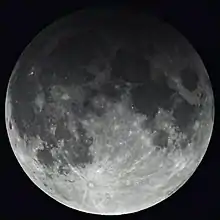February 2055 lunar eclipse
A total lunar eclipse will take place on February 11, 2055.
| Total eclipse | |||||||||||||||||
 Hourly snapshots of the Moon traveling through the Earth's shadow | |||||||||||||||||
| Date | 2055 February 11 | ||||||||||||||||
|---|---|---|---|---|---|---|---|---|---|---|---|---|---|---|---|---|---|
| Gamma | 0.3526 | ||||||||||||||||
| Magnitude | 1.2246 | ||||||||||||||||
| Saros cycle | 134 (29 of 73) | ||||||||||||||||
| Totality | 66 minutes | ||||||||||||||||
| Partiality | 198 minutes 25 seconds | ||||||||||||||||
| Penumbral | 312 minutes 52 seconds | ||||||||||||||||
| |||||||||||||||||
This eclipse is the third of an almost tetrad, the others being 22 February 2054 (T), 18 August 2054 (T) and 7 August 2055 (P).
Visibility

The entire eclipse will be visible from Africa, Europe, and the western half of Asia. Part or most of the eclipse will be visible from the Americas (except for westernmost North America), the eastern half of Asia, and western Australia.
Related lunar eclipses
Tritos series
The tritos series repeats 31 days short of 11 years at alternating nodes. Sequential events have incremental Saros cycle indices.
This series produces 23 total eclipses between June 22, 1880 and August 9, 2120.
| Ascending node | Descending node | |||||
|---|---|---|---|---|---|---|
| Saros | Date Viewing |
Type chart |
Saros | Date Viewing |
Type chart | |
| 120 | 1902 Apr 22 |
Total |
121 | 1913 Mar 22 |
Total | |
| 122 | 1924 Feb 20 |
Total |
123 | 1935 Jan 19 |
Total | |
| 124 | 1945 Dec 19 |
Total |
125 | 1956 Nov 18 |
Total | |
| 126 | 1967 Oct 18 |
Total |
127 | 1978 Sep 16 |
Total | |
| 128 | 1989 Aug 17 |
Total |
129 | 2000 Jul 16 |
Total | |
| 130 | 2011 Jun 15 |
Total |
131 | 2022 May 16 |
Total | |
| 132 | 2033 Apr 14 |
Total |
133 | 2044 Mar 13 |
Total | |
| 134 | 2055 Feb 11 |
Total |
135 | 2066 Jan 11 |
Total | |
| 136 | 2076 Dec 10 |
Total |
137 | 2087 Nov 10 |
Total | |
| 138 | 2098 Oct 10 |
Total | ||||
Inex series
The inex series repeats eclipses 20 days short of 29 years, repeating on average every 10571.95 days. This period is equal to 358 lunations (synodic months) and 388.5 draconic months. Saros series increment by one on successive Inex events and repeat at alternate ascending and descending lunar nodes.
This period is 383.6734 anomalistic months (the period of the Moon's elliptical orbital precession). Despite the average 0.05 time-of-day shift between subsequent events, the variation of the Moon in its elliptical orbit at each event causes the actual eclipse time to vary significantly. It is a part of Lunar Inex series 35.
| Descending node | Ascending node | Descending node | Ascending node | ||||
|---|---|---|---|---|---|---|---|
| Saros | Date Chart |
Saros | Date Chart |
Saros | Date Chart |
Saros | Date Chart |
| 115 | 1505 Feb 18 |
116 | 1534 Jan 30 |
117 | 1563 Jan 9 | 118 | 1591 Dec 30 |
| 119 | 1620 Dec 9 | 120 | 1649 Nov 19 | 121 | 1678 Oct 29 | 122 | 1707 Oct 11 |
| 123 | 1736 Sep 20 | 124 | 1765 Aug 30 | 125 | 1794 Aug 11 | 126 | 1823 Jul 23 |
| 127 | 1852 Jul 1 | 128 | 1881 Jun 12 | 129 | 1910 May 24 |
130 | 1939 May 3 |
| 131 | 1968 Apr 13 |
132 | 1997 Mar 24 |
133 | 2026 Mar 3 |
134 | 2055 Feb 11 |
| 135 | 2084 Jan 22 |
136 | 2113 Jan 2 | 137 | 2141 Dec 13 | 138 | 2170 Nov 23 |
| 139 | 2199 Nov 2 | 140 | 2228 Oct 14 | 141 | 2257 Sep 24 | 142 | 2286 Sep 3 |
| 143 | 2315 Aug 16 | 144 | 2344 Jul 26 | 145 | 2373 Jul 5 | 146 | 2402 Jun 16 |
| 147 | 2431 May 27 | 148 | 2460 May 5 |
149 | 2489 Apr 16 | ||
Lunar year series
| Ascending node | Descending node | |||||
|---|---|---|---|---|---|---|
| Saros | Date Viewing |
Type Chart |
Saros | Date Viewing |
Type Chart | |
| 114 | 2053 Mar 04 |
Penumbral |
119 | 2053 Aug 29 |
Penumbral | |
| 124 | 2054 Feb 22 |
Total |
129 | 2054 Aug 18 |
Total | |
| 134 | 2055 Feb 11 |
Total |
139 | 2055 Aug 07 |
Partial | |
| 144 | 2056 Feb 01 |
Penumbral |
149 | 2056 Jul 26 |
Partial | |
| Last set | 2052 Apr 14 | Last set | 2052 Oct 08 | |||
| Next set | 2056 Dec 22 | Next set | 2056 Jun 27 | |||

_(cropped).jpg.webp)
